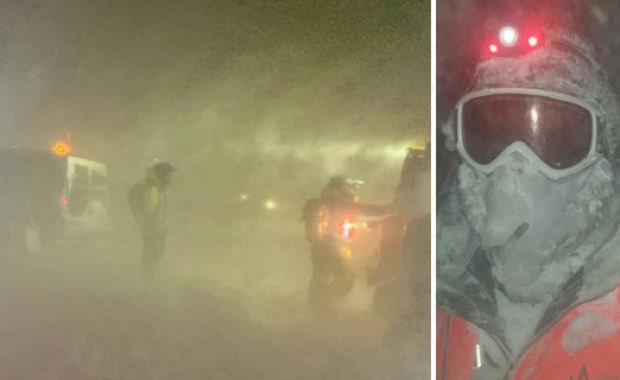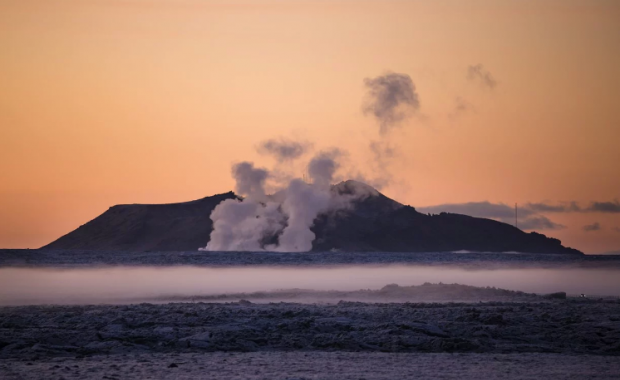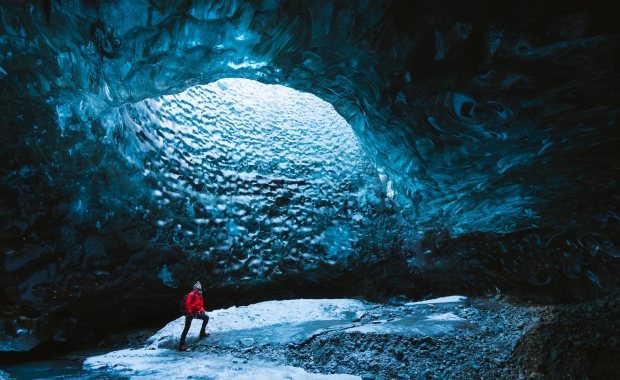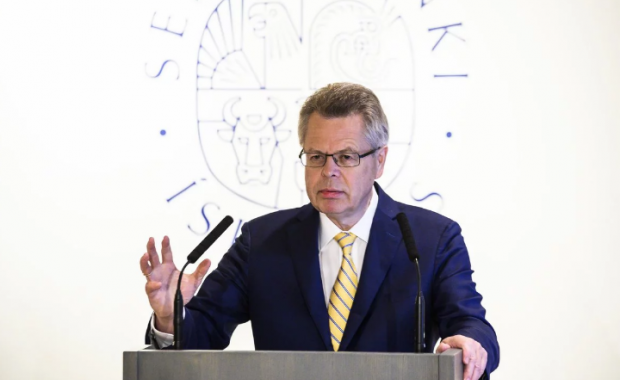The north coast of Reykjavík has magnificent views of the Kollafjörður fjord with its islands and the mountains north of Reykjavík. Visit the Sun Voyager Sculpture, Höfði house, the location of the 1986 Reykjavík Summit between Ronald Reagan and Mikhail Gorbachev and Borgartún street, the Wall Street of Iceland. You can take the ferry to Viðey Island or walk to Laugardalur valley and dip into Laugardalslaug geothermal pool, the largest public pool in Iceland.
A great afternoon stroll on a beautiful day, complete with the best Reykjavík has to offer: Amazing views of magnificent nature, a splash in a geothermal pool topped off with great beer and good food.
Harpa and the failed World Trade Center Reykjavík

We start at Harpa Concert Hall with it's distinctive glass dome designed by Icelandic artist Ólafur Elíasson. The concert hall, opened in 2011, was originally part of a re-development of the harbour area which would have included the headquarters of the failed Landsbankinn bank and dubbed The World Trade Center Reykjavík.
The 2008 financial crisis brought these plans to a halt: The empty construction site next to Harpa is all which remains of the planned bank headquarters.
The neighborhood of shadows

Walking east along the coast from Harpa we first pass the highrise condos in the Skuggahverfi neighbourhood. Skuggahverfið used to be an industrial area and low-income and working-class neighbourhood. It derives its name after the small 19th century farm Skuggi, as the name translates as the Neighbourhood of Skuggi. But since skuggi means shadow the name of the neighbourhood can be translated as the Neighbourhood of shadows.
Read more: Iceland Airwaves teams up bands and street artists to transform Reykjavík walls into giant artwork
In the 1990s the re-development of the neighbourhood began with the building of high-rise condos along the coast. Some of the most expensive real estate in Reykjavík is found in these towers, thanks to their breathtaking views of the city.
The ministry of fisheries was decorated in 2015 with a giant mural painted by the Dominical born graffiti artist Evoca 1.
The Sun Voyager
The steel sculpture The Sun Voyager overlooks Kollafjörður fjord. A popular destination for scenic photographs. The sculpture was made by Icelandic artist Jón Gunnar Arnason. Although many feel it resembles a Viking ship, the artist intended it as a dream vessel, and an ode to the sun.
The sculpture was unveiled in 1990 to commemorate the 200th anniversary of the City of Reykjavík.
The view from the Sun Voyager

Reykjavík stands by Faxaflói bay, but the fjord between the Reykjavík peninsula and Mount Esja to the north is called Kollafjörður. Kollafjörður is known for its bird life, as the islands in the fjord are home to sea bird colonies.
The mountain view is dominated by two mountains: Akrafjall to the west and mount Esja to the east. At the west tip of Akrafjall stands the fishing town Akranes. The northernmost suburbs of Reykjavík cling to the coast beneath the side of Esja.
The islands seen from the Sun Voyager are Engey (to the west) and Viðey (to the east). Neither Island is currently inhabited. Engey island was inhabited until 1950 but is currently only home to birds who nest there.
In the 19th and early 20th century the small, but prosperous fishing village in Viðey was a formidable competitor to the town on the mainland. The trawling industry in Viðey went bankrupt in the Great Depression, and the village was abandoned in the 1940s.
Other sculptures

Walking east from the Sun Voyager we first walk past a work by the sculptor Jóhann Eyfells, The Cairn. Jóhann was born in Reykjavík in 1923, but lived most of his life in the US. Jóhann is currently living in Texas, where he continues to work with his wife Kristín Eyfells.
It is easy to miss the next sculpture by the walking pat, a hidden installation by the artist Sigurður Guðmundsson sits in the breakwater: A number of polished rocks hide in the breakwater by the intersection of Snorrabraut and Sæbraut.
Further east is the sculpture Partnership by Pétur Bjarnason, a bronze sculpture which commemorates the 50 year anniversary of the diplomatic relations between Iceland and the US. The sculpture has a sister sculpture in Miami Florida, unveiled in 1992.
The Wall Street of Iceland

If we continue past the sculpture Partnership we see to our left the high-rise office tower of Höfðatorg and the office blocks of Borgartún street. In the 2000s the street Borgartún became the center of finance in Iceland as new office buildings were constructed to accommodate the booming financial sector of the Icelandic financial miracle.
Read more: Bankers Behind Bars: A guided walking tour through the collapse of Iceland's banking system in 2008
The headquarters of failed Kaupþing stand next to the historic building Höfði. Further to the east stand the now abandoned headquarters of failed Glitnir.
In the roundabout in front of Höfðatorg high-rise office tower is a wafer thin sculpture Obtusa by US based Rafael Barrios. The sculpture is owned by Skúli Mogensen, the CEO of WOW air, and is on loan to the City of Reykjavík.
The Reykjavík Summit

Höfði House, built in 1909, best known as the location of the 1986 summit meeting of the president of the US, Ronald Reagan and the leader of the Soviet Union, Mikhail Gorbachev, which is seen as the beginning of the end of the cold war.
It was built as the home of the French consul in Iceland, and over the decades celebrities and heads of state have stayed at the house, including the Queen of England, Winston Churchill and Marlene Dietrich.
In front of Höfði is a sculpture by Sigurjón Ólafsson, Öndvegissúlur depicting the throne pillars of Ingólfur Arnarson, the first settler of Reykjavík. A piece of the Berlin wall, given to Reykjavík by the City of Berlin in 2016 stands in front of Höfði by Borgartún street.
Laugarnes peninsula
At the end of the scenic coast walk is Laugarnes peninsula, an archeological site where the remains of a settlement which dates back to the Viking age have been found. The peninsula is also the last part of the north coast of Reykjavík which has not been altered by landfills.
The museum of the sculptor Sigurjón Ólafsson stands in Laugarnes.
Viðey island

Next to Laugarnes is Sundahöfn harbour, the largest container harbour in Iceland. A short ferry ride from Sundahöfn harbour takes you to Viðey Island. Viðey is rich in history and offers an extensive network of trails.
During the summer the ferry sails once every hour, allowing you to take a quick boat ride out to Viðey, where you can either stroll around, enjoying the scenery, walk to the east end of the island to explore the ruins of the once prosperous fishing village which was abandoned in the 1940s.
You can also walk to the west end of the island to visit two impressive art projects, the Imagine Peace Tower by Yoko Ono and the Milestones Project by sculptor Richard Serra.
Before you sail back to land, be sure to visit Viðey House, one of the oldest stone buildings in Iceland. A café and restaurant is operated in the house during the summer months.
Laugardalurinn valley

Another option is to walk to Laugardalurinn valley recreational area. Laugardalurinn is a major geothermal area. Until the early 20th century hot springs and natural baths in the valley were used for bathing and to wash clothes.
Read more: Nine fascinating facts about geothermal energy and Reykjavík
Today no geothermal activity can be seen on the surface, as the energy is harnessed by bore holes which produce 8% of all the hot water used in the Metropolitan area. Laugardalurinn is home to the largest public swimming pool in Iceland, the Laugardalslaugin public pool.
The north coast of Reykjavík has magnificent views of the Kollafjörður fjord with its islands and the mountains north of Reykjavík. Visit the Sun Voyager Sculpture, Höfði house, the location of the 1986 Reykjavík Summit between Ronald Reagan and Mikhail Gorbachev and Borgartún street, the Wall Street of Iceland. You can take the ferry to Viðey Island or walk to Laugardalur valley and dip into Laugardalslaug geothermal pool, the largest public pool in Iceland.
A great afternoon stroll on a beautiful day, complete with the best Reykjavík has to offer: Amazing views of magnificent nature, a splash in a geothermal pool topped off with great beer and good food.
Harpa and the failed World Trade Center Reykjavík

We start at Harpa Concert Hall with it's distinctive glass dome designed by Icelandic artist Ólafur Elíasson. The concert hall, opened in 2011, was originally part of a re-development of the harbour area which would have included the headquarters of the failed Landsbankinn bank and dubbed The World Trade Center Reykjavík.
The 2008 financial crisis brought these plans to a halt: The empty construction site next to Harpa is all which remains of the planned bank headquarters.
The neighborhood of shadows
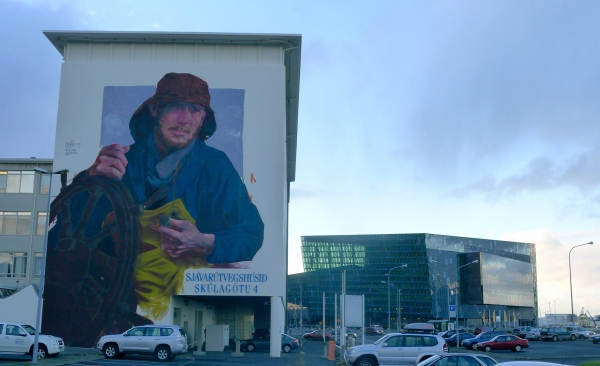
Walking east along the coast from Harpa we first pass the highrise condos in the Skuggahverfi neighbourhood. Skuggahverfið used to be an industrial area and low-income and working-class neighbourhood. It derives its name after the small 19th century farm Skuggi, as the name translates as the Neighbourhood of Skuggi. But since skuggi means shadow the name of the neighbourhood can be translated as the Neighbourhood of shadows.
Read more: Iceland Airwaves teams up bands and street artists to transform Reykjavík walls into giant artwork
In the 1990s the re-development of the neighbourhood began with the building of high-rise condos along the coast. Some of the most expensive real estate in Reykjavík is found in these towers, thanks to their breathtaking views of the city.
The ministry of fisheries was decorated in 2015 with a giant mural painted by the Dominical born graffiti artist Evoca 1.
The Sun Voyager
The steel sculpture The Sun Voyager overlooks Kollafjörður fjord. A popular destination for scenic photographs. The sculpture was made by Icelandic artist Jón Gunnar Arnason. Although many feel it resembles a Viking ship, the artist intended it as a dream vessel, and an ode to the sun.
The sculpture was unveiled in 1990 to commemorate the 200th anniversary of the City of Reykjavík.
The view from the Sun Voyager
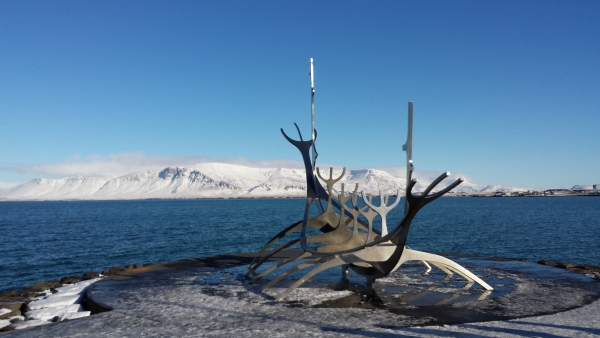
Reykjavík stands by Faxaflói bay, but the fjord between the Reykjavík peninsula and Mount Esja to the north is called Kollafjörður. Kollafjörður is known for its bird life, as the islands in the fjord are home to sea bird colonies.
The mountain view is dominated by two mountains: Akrafjall to the west and mount Esja to the east. At the west tip of Akrafjall stands the fishing town Akranes. The northernmost suburbs of Reykjavík cling to the coast beneath the side of Esja.
The islands seen from the Sun Voyager are Engey (to the west) and Viðey (to the east). Neither Island is currently inhabited. Engey island was inhabited until 1950 but is currently only home to birds who nest there.
In the 19th and early 20th century the small, but prosperous fishing village in Viðey was a formidable competitor to the town on the mainland. The trawling industry in Viðey went bankrupt in the Great Depression, and the village was abandoned in the 1940s.
Other sculptures

Walking east from the Sun Voyager we first walk past a work by the sculptor Jóhann Eyfells, The Cairn. Jóhann was born in Reykjavík in 1923, but lived most of his life in the US. Jóhann is currently living in Texas, where he continues to work with his wife Kristín Eyfells.
It is easy to miss the next sculpture by the walking pat, a hidden installation by the artist Sigurður Guðmundsson sits in the breakwater: A number of polished rocks hide in the breakwater by the intersection of Snorrabraut and Sæbraut.
Further east is the sculpture Partnership by Pétur Bjarnason, a bronze sculpture which commemorates the 50 year anniversary of the diplomatic relations between Iceland and the US. The sculpture has a sister sculpture in Miami Florida, unveiled in 1992.
The Wall Street of Iceland
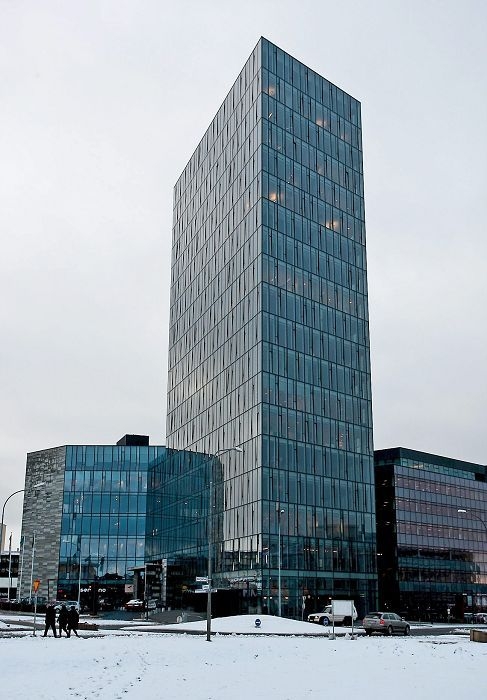
If we continue past the sculpture Partnership we see to our left the high-rise office tower of Höfðatorg and the office blocks of Borgartún street. In the 2000s the street Borgartún became the center of finance in Iceland as new office buildings were constructed to accommodate the booming financial sector of the Icelandic financial miracle.
Read more: Bankers Behind Bars: A guided walking tour through the collapse of Iceland's banking system in 2008
The headquarters of failed Kaupþing stand next to the historic building Höfði. Further to the east stand the now abandoned headquarters of failed Glitnir.
In the roundabout in front of Höfðatorg high-rise office tower is a wafer thin sculpture Obtusa by US based Rafael Barrios. The sculpture is owned by Skúli Mogensen, the CEO of WOW air, and is on loan to the City of Reykjavík.
The Reykjavík Summit
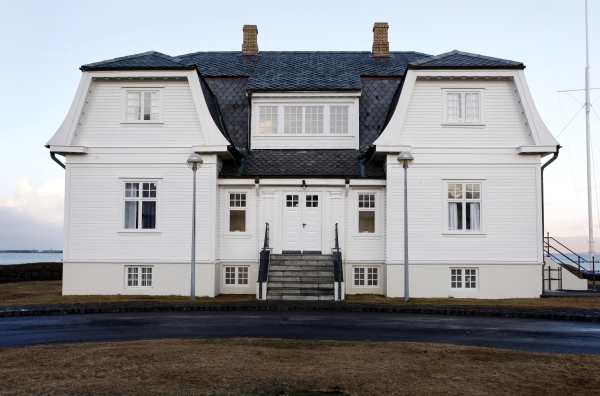
Höfði House, built in 1909, best known as the location of the 1986 summit meeting of the president of the US, Ronald Reagan and the leader of the Soviet Union, Mikhail Gorbachev, which is seen as the beginning of the end of the cold war.
It was built as the home of the French consul in Iceland, and over the decades celebrities and heads of state have stayed at the house, including the Queen of England, Winston Churchill and Marlene Dietrich.
In front of Höfði is a sculpture by Sigurjón Ólafsson, Öndvegissúlur depicting the throne pillars of Ingólfur Arnarson, the first settler of Reykjavík. A piece of the Berlin wall, given to Reykjavík by the City of Berlin in 2016 stands in front of Höfði by Borgartún street.
Laugarnes peninsula
At the end of the scenic coast walk is Laugarnes peninsula, an archeological site where the remains of a settlement which dates back to the Viking age have been found. The peninsula is also the last part of the north coast of Reykjavík which has not been altered by landfills.
The museum of the sculptor Sigurjón Ólafsson stands in Laugarnes.
Viðey island
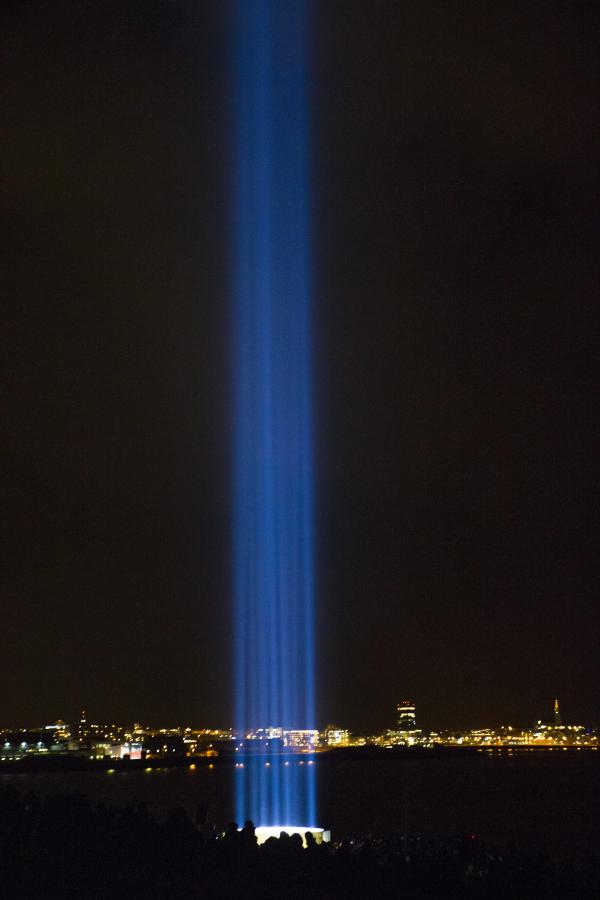
Next to Laugarnes is Sundahöfn harbour, the largest container harbour in Iceland. A short ferry ride from Sundahöfn harbour takes you to Viðey Island. Viðey is rich in history and offers an extensive network of trails.
During the summer the ferry sails once every hour, allowing you to take a quick boat ride out to Viðey, where you can either stroll around, enjoying the scenery, walk to the east end of the island to explore the ruins of the once prosperous fishing village which was abandoned in the 1940s.
You can also walk to the west end of the island to visit two impressive art projects, the Imagine Peace Tower by Yoko Ono and the Milestones Project by sculptor Richard Serra.
Before you sail back to land, be sure to visit Viðey House, one of the oldest stone buildings in Iceland. A café and restaurant is operated in the house during the summer months.
Laugardalurinn valley
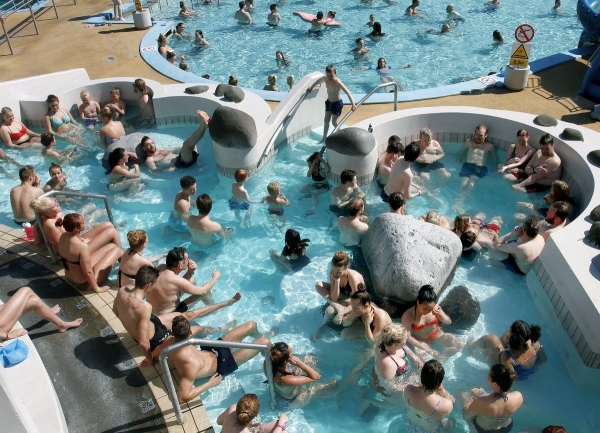
Another option is to walk to Laugardalurinn valley recreational area. Laugardalurinn is a major geothermal area. Until the early 20th century hot springs and natural baths in the valley were used for bathing and to wash clothes.
Read more: Nine fascinating facts about geothermal energy and Reykjavík
Today no geothermal activity can be seen on the surface, as the energy is harnessed by bore holes which produce 8% of all the hot water used in the Metropolitan area. Laugardalurinn is home to the largest public swimming pool in Iceland, the Laugardalslaugin public pool.



